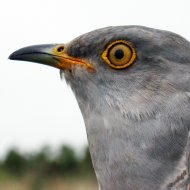It is April 25, 2016, and I’m still listening, I fear increasingly in vain, for what we describe as “our” cuckoo.
For a bird that advertises itself so clearly and unmistakably, the cuckoo and its movements are clouded in mystery. It could be that the cuckoos, and their progeny over many years, are not returning here because the birds whose nests they use, the meadow pipits, dunnocks and reed warblers, are in decline, or because their breeding season no longer coincides with that of the cuckoo because of a changing climate. Does the irregular arrival of spring affect some birds’ nestbuilding and egg laying? Some years they may be nesting earlier, too soon for the arriving cuckoos. In other years they nest too late.
Or it could be something happening to the cuckoo in that long period from late June until early April, during which they are absent from the UK.
The British Trust for Ornithology (BTO) says the UK has lost over half its cuckoos over the past 20 years. Idle bar-room speculation won’t give us an answer. But trackers that the BTO, since 2011, has fitted to about 50 cuckoos in the UK could help us to understand what is happening. Already it has gathered useful data about migratory routes.
But back to “our” cuckoo. We live on the edge of a village in rural Buckinghamshire. For over 20 years, in the third or the fourth week of April, we would first hear a cuckoo in the countryside to the north of our house. From then on, we would hear it, or another, or others (how could we possibly know) almost without fail, daily, for the next four or five weeks.
Cuckoos return to the area where they were born, so it is likely that several generations in the same lineage returned to this same area of fields and hedges and woodland around the Grand Union Canal.
Sometimes the bird arrived a week or so late, after its prodigious travels from south of the Sahara. Rarely was it earlier than about April 20th. The call of the cuckoo was so predictable, I grew complacent about it. I pitied friends in London who would rarely if ever hear the cuckoo in spring. Weren’t we the fortunate ones?
I recall the year it didn’t turn up. In 2011 or 2012 it arrived, eventually, and called a few desultory times. Then in 2013 I heard it only once. It was in 2014 when I didn’t hear it at all from our garden. In 2015, there was one call.
There are no physical changes to explain its absence, no new housing estate built, no switch to intensive agriculture – the fields I mention are not cultivated, although other fields close by are, and treated I suppose with the usual cocktail of chemicals.
We can at least study these changing conditions. But what about that time when they are absent from the UK? We knew nothing. Until a few years ago, the only record of a cuckoo ringed in the UK was a bird found in Cameroon 82 years ago.
Technology now allows the BTO to track certain cuckoos the whole winter through. Very light (5g) tags were fitted in Britain to five cuckoos in May 2011. The tags are solar-powered, transmitting for 10 hours. They then go into sleep mode for 48 hours, allowing the tiny solar panel to recharge the battery.
The first tagged cuckoo to return to the UK this year (2016) is “Stanley”. The BTO knows he started his journey from Ivory Coast in west Africa on 7th April and 3,000 miles later, (21st of April) he was back in England, just south of Yeovil. Two other cuckoos, Coo and Disco Tony have made it across the perilous Sahara and on into Spain.
What else does the BTO know? That the birds appear to follow two distinct flight paths. One is through the western Mediterranean, through Spain, Morocco and West Africa; the other is down through Italy and across the central Sahara. Cuckoos tagged in the UK spend the winter in central Africa, mainly in and around the Congo rainforest.
The BTO has also been able to show how early in the summer it leaves the UK. We know the bird stops its regular calling quite early – “In June I change my tune; In July away I fly.” But now we know for sure that their departure takes place as early as late June.
The BTO says the cuckoos head out of the UK in a variety of directions, some east across the North Sea to the Netherlands and Belgium, while others head south across the Channel into France.
By the 25 June, 2015, two of the three cuckoos tagged in the North Yorkshire Moors had left the country. Signals from one showed it crossing the Channel on 22 June; by 24 June it had travelled 965km (600 miles) to Italy and was west of Venice. It then headed north-east, to stop in Slovenia. Another was in the Champagne-Ardenne region of France by 24 June, 620km (390 miles) from his last location in Yorkshire.
That is bird watching watching at its most sophisticated and scientifically valuable.

